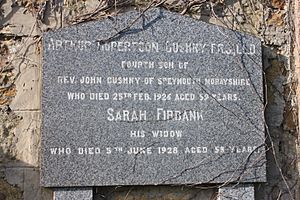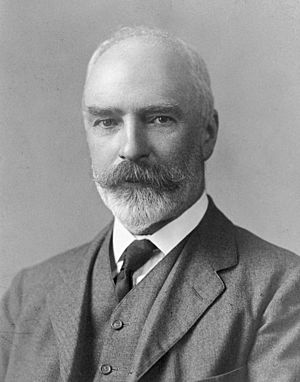Arthur Robertson Cushny facts for kids

Arthur Robertson Cushny (born 1866, died 1926) was an important Scottish scientist. He was a pharmacologist and a physiologist. A pharmacologist studies how medicines affect the body. A physiologist studies how living things work. Cushny became a Fellow of the Royal Society, which is a big honor for scientists.
Contents
Life and Education
Arthur Cushny was born on March 6, 1866, in Fochabers, a town in Moray, Scotland. He was the fourth son of Reverend John Cushny.
He went to a local school and then studied at the University of Aberdeen. He earned his first degree, an M.A., in 1886. Later, in 1889, he finished his medical studies at Marischal College in Aberdeen. He received several medical degrees by 1892.
Learning About Medicines
Arthur Cushny was very interested in how medicines affect the body. To learn more, he traveled to Europe. He spent a year studying in Straßburg, which was part of the German Empire at the time. He learned from a famous scientist named Oswald Schmiedeberg. He also spent six months in Berne, Switzerland, learning new scientific methods.
In 1893, when he was 27, he moved to the United States. He became the head of the pharmacology department at the University of Michigan. While there, he taught students, did research, and wrote a very important book. This book was called Text-Book of Pharmacology and Therapeutics. It was considered the best book on the subject for about 30 years.
Important Discoveries
Cushny made many important contributions to the field of pharmacology.
- Understanding Heart Medicines: He was the first to carefully study how a heart medicine called digitalis works. He used the best methods of his time to test it on animals. His work helped doctors understand how digitalis affects the heart. This made the medicine much safer and more useful for patients.
- Heart Rhythm Problems: He was also the first to notice that a common heart rhythm problem in people, called auricular fibrillation, looked very similar to what he saw in his experiments. This helped doctors understand the condition better.
- Kidney Function: Cushny also spent several years studying how kidneys work. Kidneys are organs that clean your blood. In 1917, he wrote a paper called The Secretion of Urine. In this paper, he explained his "modern theory" of how kidneys filter waste. He said that the main parts of the kidney, called glomeruli, simply filter out harmful waste from the blood. Then, useful nutrients are reabsorbed back into the body through tiny tubes called renal tubules. This idea was a big step forward in understanding how our bodies work.
Later Career and Life
In 1905, Arthur Cushny moved back to the United Kingdom. He became the head of pharmacology at University College London (UCL). Then, in 1918, he moved to Edinburgh, Scotland, to take over a similar position at the University of Edinburgh. He stayed there until he passed away.
He received many honors for his work. In 1907, he became a Fellow of the Royal Society of London. In 1919, he was also elected a Fellow of the Royal Society of Edinburgh.
While living in Edinburgh, he bought a historic house. He enjoyed spending time in his garden and was a keen gardener. He often invited international medical students and doctors to his home. He married Sarah Firbank in 1896.
Arthur Cushny passed away suddenly in his home in Edinburgh, Scotland, on February 25, 1926. He is buried in Liberton Cemetery in south Edinburgh.
Notable Books
- The Action and Uses in Medicine of Digitalis and Its Allies (1925)
- The Biological Relation of Optically Isometric Substances (1926)
- The Secretion of Urine (1917)


